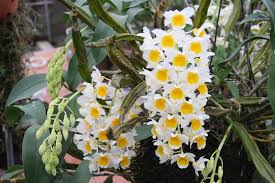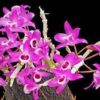# The Development of the Quế Lan Hương Orchid Industry

The Quế Lan Hương orchid, scientifically known as *Dendrobium anosmum*, is not only celebrated for its exquisite beauty and delightful fragrance but also for its significant role in the horticultural industry. This remarkable orchid, native to Southeast Asia, has captured the hearts of flower enthusiasts, gardeners, and commercial growers alike. Over the years, the Quế Lan Hương orchid industry has evolved, expanding its influence in both local and global markets. This article explores the development of the Quế Lan Hương orchid industry, focusing on its historical background, cultivation practices, market trends, and future prospects.
## 1. Historical Background
### 1.1 Origins of Quế Lan Hương
The Quế Lan Hương orchid is indigenous to countries in Southeast Asia, including Vietnam, Thailand, and the Philippines. Its striking appearance, characterized by long, cascading stems adorned with fragrant flowers, has made it a favorite among horticulturists and collectors. Historically, the orchid was used in traditional medicine and cultural practices, symbolizing beauty, love, and spirituality.
### 1.2 Early Cultivation and Trade
The cultivation of orchids dates back centuries, with Quế Lan Hương being no exception. In the past, local communities would cultivate these orchids for personal use, often exchanging them during festivals and special occasions. As interest in orchids grew, particularly during the 19th century, commercial cultivation began to take shape.
With the advent of the global flower trade, Quế Lan Hương gained recognition outside its native region. Florists and horticulturists around the world started importing these stunning orchids, further driving demand and expanding the market.
## 2. Cultivation Practices
### 2.1 Growing Conditions
Successful cultivation of Quế Lan Hương requires an understanding of its natural habitat. This orchid thrives in warm, humid environments with ample sunlight. To replicate these conditions, growers often utilize greenhouses equipped with temperature and humidity control systems.
Key factors to consider in cultivating Quế Lan Hương include:
– **Light**: The orchid requires bright, indirect sunlight. Too much direct sunlight can scorch the leaves, while too little can hinder flowering.
– **Temperature**: Quế Lan Hương prefers a temperature range of 20-30°C (68-86°F) during the day and slightly cooler temperatures at night.
– **Humidity**: Maintaining humidity levels between 50-70% is crucial for healthy growth. Misting the plants or using humidifiers can help achieve this.
### 2.2 Propagation Techniques
Propagation of Quế Lan Hương can be accomplished through various methods, including division, cuttings, and tissue culture. Each method has its advantages and challenges:
– **Division**: This is the most common method, where mature plants are divided into smaller sections, each with roots and at least one pseudobulb. This method is straightforward but requires careful handling to avoid damaging the roots.
– **Cuttings**: Growing new plants from stem cuttings can be successful, but it requires a careful approach to ensure the cuttings take root.
– **Tissue Culture**: This advanced technique allows for mass propagation under sterile conditions. It has gained popularity in the industry due to its ability to produce disease-free plants and maintain genetic consistency.
### 2.3 Pest and Disease Management
Like all plants, Quế Lan Hương is susceptible to pests and diseases. Common pests include aphids, mealybugs, and spider mites. Implementing integrated pest management strategies, such as regular inspections, maintaining cleanliness in the growing area, and using biological controls, can help mitigate these issues.
Diseases such as root rot and leaf spot can arise from overwatering or poor air circulation. Growers must ensure proper watering practices and provide adequate ventilation in the growing environment.
## 3. Market Trends
### 3.1 Growing Demand
The demand for Quế Lan Hương orchids has been steadily increasing due to their aesthetic appeal and unique characteristics. As consumers become more interested in indoor gardening and houseplants, orchids have gained popularity as suitable choices for home décor. Their exotic appearance and fragrant flowers make them desirable for floral arrangements and gifts.
### 3.2 Export Markets
Southeast Asia has become a significant exporter of Quế Lan Hương orchids, with countries like Vietnam leading the way. The growing global demand for orchids has opened up new markets in Europe, North America, and Asia. Exporters have developed strong relationships with international buyers, participating in flower fairs and exhibitions to showcase their products.
### 3.3 E-commerce Growth
The rise of e-commerce has transformed the flower industry, allowing consumers to purchase Quế Lan Hương orchids online. This shift has enabled growers and retailers to reach a wider audience, facilitating direct sales to consumers. Online platforms also provide a space for education and promotion, helping to raise awareness of the unique qualities of Quế Lan Hương.
## 4. Challenges Facing the Industry
### 4.1 Climate Change
The orchid industry, including the cultivation of Quế Lan Hương, faces challenges related to climate change. Fluctuating temperatures, altered precipitation patterns, and extreme weather events can impact cultivation practices and yield. Growers must adapt their techniques to mitigate these effects, such as utilizing climate-resilient practices and technology.
### 4.2 Competition
As the popularity of orchids grows, competition within the industry has intensified. Many growers are entering the market, leading to oversupply and price fluctuations. To remain competitive, established growers must innovate and focus on quality, unique varieties, and customer engagement.
### 4.3 Sustainability Concerns
Sustainable practices in horticulture have become increasingly important. The Quế Lan Hương industry must address concerns related to resource usage, waste management, and the impact of cultivation on local ecosystems. Implementing sustainable practices, such as using organic fertilizers, reducing water consumption, and promoting biodiversity, can enhance the industry’s reputation and long-term viability.
## 5. Future Prospects
### 5.1 Technological Advancements
The future of the Quế Lan Hương orchid industry is likely to be shaped by technological advancements. Innovations in cultivation techniques, such as automated systems for climate control and pest management, can enhance efficiency and productivity. Additionally, advances in genetics and tissue culture may lead to the development of new varieties with improved traits.
### 5.2 Increasing Popularity of Indoor Gardening
As urban living spaces become more compact, the trend of indoor gardening is on the rise. Quế Lan Hương orchids are well-suited for indoor environments, making them an attractive choice for apartment dwellers and gardening enthusiasts. The industry can capitalize on this trend by providing educational resources and promoting the ease of care for these orchids.
### 5.3 Strengthening Community and Collaboration
The future of the Quế Lan Hương orchid industry also lies in fostering community and collaboration among growers, researchers, and consumers. Sharing knowledge, resources, and best practices can enhance the overall quality of orchids produced and contribute to sustainable growth. Collaborative efforts in research and development can address challenges and promote innovation in cultivation and marketing.
## 6. Conclusion
The Quế Lan Hương orchid industry has undergone significant development over the years, evolving from traditional cultivation practices to a thriving global market. As interest in these exquisite flowers continues to grow, the industry faces both challenges and opportunities. By embracing sustainable practices, leveraging technological advancements, and adapting to changing consumer preferences, the Quế Lan Hương orchid industry is well-positioned for future success.
In conclusion, the Quế Lan Hương orchid not only represents beauty and elegance but also serves as a testament to the resilience and creativity of those who cultivate and cherish it. As we look ahead, it is essential to continue supporting this industry, celebrating its heritage, and promoting its future.

